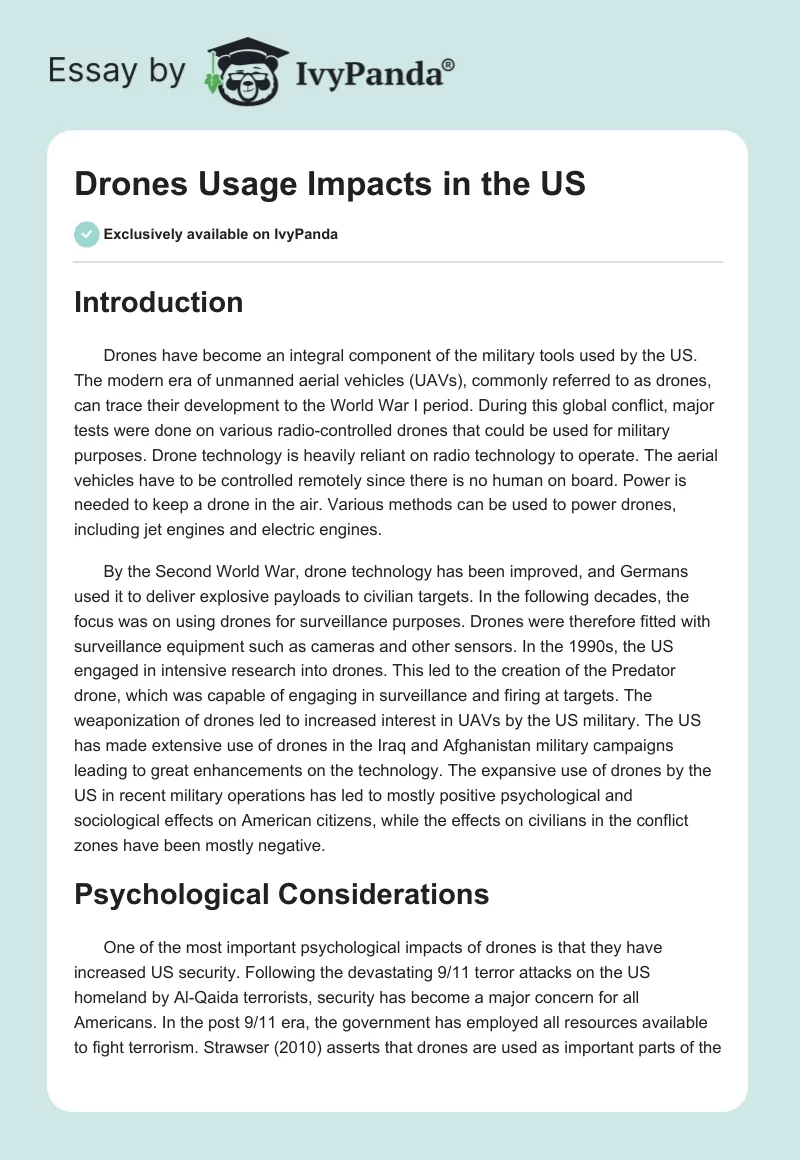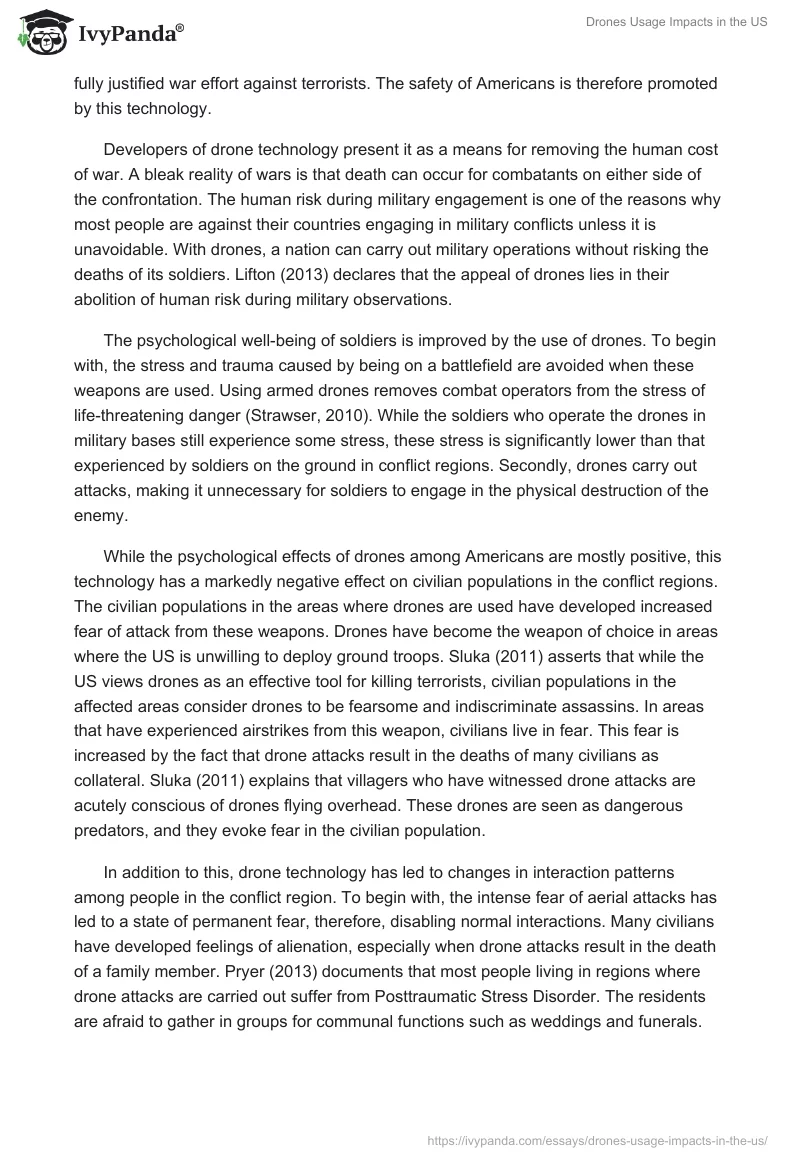Introduction
Drones have become an integral component of the military tools used by the US. The modern era of unmanned aerial vehicles (UAVs), commonly referred to as drones, can trace their development to the World War I period. During this global conflict, major tests were done on various radio-controlled drones that could be used for military purposes. Drone technology is heavily reliant on radio technology to operate. The aerial vehicles have to be controlled remotely since there is no human on board. Power is needed to keep a drone in the air. Various methods can be used to power drones, including jet engines and electric engines.
By the Second World War, drone technology has been improved, and Germans used it to deliver explosive payloads to civilian targets. In the following decades, the focus was on using drones for surveillance purposes. Drones were therefore fitted with surveillance equipment such as cameras and other sensors. In the 1990s, the US engaged in intensive research into drones. This led to the creation of the Predator drone, which was capable of engaging in surveillance and firing at targets. The weaponization of drones led to increased interest in UAVs by the US military. The US has made extensive use of drones in the Iraq and Afghanistan military campaigns leading to great enhancements on the technology. The expansive use of drones by the US in recent military operations has led to mostly positive psychological and sociological effects on American citizens, while the effects on civilians in the conflict zones have been mostly negative.
Psychological Considerations
One of the most important psychological impacts of drones is that they have increased US security. Following the devastating 9/11 terror attacks on the US homeland by Al-Qaida terrorists, security has become a major concern for all Americans. In the post 9/11 era, the government has employed all resources available to fight terrorism. Strawser (2010) asserts that drones are used as important parts of the fully justified war effort against terrorists. The safety of Americans is therefore promoted by this technology.
Developers of drone technology present it as a means for removing the human cost of war. A bleak reality of wars is that death can occur for combatants on either side of the confrontation. The human risk during military engagement is one of the reasons why most people are against their countries engaging in military conflicts unless it is unavoidable. With drones, a nation can carry out military operations without risking the deaths of its soldiers. Lifton (2013) declares that the appeal of drones lies in their abolition of human risk during military observations.
The psychological well-being of soldiers is improved by the use of drones. To begin with, the stress and trauma caused by being on a battlefield are avoided when these weapons are used. Using armed drones removes combat operators from the stress of life-threatening danger (Strawser, 2010). While the soldiers who operate the drones in military bases still experience some stress, these stress is significantly lower than that experienced by soldiers on the ground in conflict regions. Secondly, drones carry out attacks, making it unnecessary for soldiers to engage in the physical destruction of the enemy.
While the psychological effects of drones among Americans are mostly positive, this technology has a markedly negative effect on civilian populations in the conflict regions. The civilian populations in the areas where drones are used have developed increased fear of attack from these weapons. Drones have become the weapon of choice in areas where the US is unwilling to deploy ground troops. Sluka (2011) asserts that while the US views drones as an effective tool for killing terrorists, civilian populations in the affected areas consider drones to be fearsome and indiscriminate assassins. In areas that have experienced airstrikes from this weapon, civilians live in fear. This fear is increased by the fact that drone attacks result in the deaths of many civilians as collateral. Sluka (2011) explains that villagers who have witnessed drone attacks are acutely conscious of drones flying overhead. These drones are seen as dangerous predators, and they evoke fear in the civilian population.
In addition to this, drone technology has led to changes in interaction patterns among people in the conflict region. To begin with, the intense fear of aerial attacks has led to a state of permanent fear, therefore, disabling normal interactions. Many civilians have developed feelings of alienation, especially when drone attacks result in the death of a family member. Pryer (2013) documents that most people living in regions where drone attacks are carried out suffer from Posttraumatic Stress Disorder. The residents are afraid to gather in groups for communal functions such as weddings and funerals.
The drone technology plays a part in fulfilling the human safety needs present in Maslow’s hierarchy of needs. According to this hierarchy, safety needs are some of the most basic needs for human beings. These needs have to be met for individuals to lead a fulfilling life. The drone technology meets these needs by bolstering American protection from attacks by terrorists.
Sociological Effects
Extensive drone use has led to the growth of a drone industry, leading to the emergence of large organizations that prosper because of the growing demand for this technology. The successful use of drones combined with the perceived low risk to US personnel has made this technology hugely attractive (Pryer, 2013). This has created a great demand for these devices by the US military and other countries. Large organizations have prospered because of the demand for this technology.
The efficiency of the military is increased when drones are used since there is no immediate risk to the soldiers involved in the attack. When using conventional war tactics, soldiers are forced to act quickly and neutralize an enemy or get out of the conflict area. This reduces the efficiency of military operations since it is difficult to engage in precise actions. Drones remove the direct personal risk that US forces might face (Anderson, 2013). This makes it possible for them to take their time to choose the best moment to make an attack — the lack of immediate danger results in effective strikes against the enemy.
There has been increased mistrust of local authorities that allow the use of drones and the US government. Fair et al. (2014) report that the frequent use of drones has led to great distrust of the US by people in Pakistan and Afghanistan. The high percentage of civilian deaths caused by drone strikes has aggravated the population leading to feelings of anger. Pakistani civilians who have been affected by these strikes are distrustful of their government since they view it as incompetent in protecting them from the indiscriminate killing through drones. They also view the US as an enemy and oppose the drone program. The use of drones has therefore served to undermine public support for the Afghan and Pakistani government. Sluka (2011) warns that extensive use of drones can lead to a loss of government control over its citizenry.
Drones have fostered mistrust among local populations in areas where drone attacks are implemented as people accuse each other of being informants. Drones are primarily used to carry out precise attacks against military targets. These targets are often hard to identify, and significant intelligence assessment has to be carried out before positive identification can be made. In addition to surveillance collected through aerial observations, drones rely on the intelligence provided by the spy networks on the ground in the conflict region to make precise attacks. As such, the conflict areas have informants who provide information that can be used to identify and attack terrorist targets. Fair et al. (2014) report that the US has established ground-level human-intelligence networks in Afghanistan and Pakistan to assist in targeting decisions for drones. This has led to heightened levels of suspicion among villagers who may suspect their neighbors of being informants.
Civilians are encouraged to join terrorist groups out of feelings of victimization due to the indiscriminate killings by drones. Pryer (2013) notes that drone attacks have intensified support for terrorist organizations creating a large supply of recruits for these anti-American groups. A UN report suggests that US drone attacks in Afghanistan are fueling suicide attacks in the country (Sluka, 2011). In many cases, civilians join insurgencies after drone attacks kill their family members or friends.
Drones are effective in disputing the activities of terrorist communities stationed in remote regions. The normal functioning of these communities is disrupted since the members can no longer operate freely due to the fear of imminent drone attacks. Anderson (2013) documents that the drone can operate at very slow speed and spend long periods of times, loitering over the object of interest. This makes it possible to engage in surveillance of technologically unsophisticated but potentially dangerous actors. Most potential targets of drone attacks are aware that drones might be hovering over their location at any given time. As such, dangerous actors are constantly aware that they are vulnerable to attacks.
Conclusion
This paper set out to discuss the psychological considerations and sociological effects of using drone technology in military operations. It began by discussing the science that drives this technology and how drones have been applied for military purposes. The overall impact of drones for the American population is positive as they lead to increased safety and reduced psychological distress among soldiers. However, the impact is negative for citizens in the regions where this technology is deployed. It can be expected that this technology will continue being used even more expansively in future years.
References
Anderson, K. (2013). The Case for Drones. Commentary, 135(6), 14-23.
Fair, C.C., Kaltenthaler, K., & Miller, W.J. (2014). Pakistani Opposition to American Drone Strikes. Political Science Quarterly, 129(1), 1-33.
Lifton, R.J. (2013). The dimensions of contemporary war and violence: How to reclaim humanity from a continuing revolution in the technology of killing. Bulletin of the Atomic Scientists, 69(4), 9-17.
Pryer, D. (2013). The Rise of the Machines. Military Review, 93(2), 14-24.
Sluka, J. (2011). Death from Above: UAVs and Losing Hearts and Minds. Military Review, 91(3), 89-95.
Strawser, B.J. (2010). Moral Predators: The Duty to Employ Uninhabited Aerial Vehicles. Journal of Military Ethics, 9(4), 342-368.


